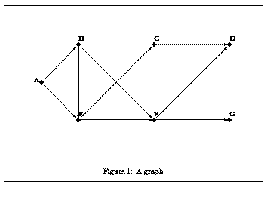
An alternative representation of the graph: the nodes are intersections in a city, the arrows are one-way streets; the nodes are stations in a hospital, the arrows are ways to move a patient from one station to another; the nodes are pipeline joints, the arrows are pipelines, etc.
A Scheme representation:
(define Graph
'((A (B E))
(B (E F))
(C (D))
(D ())
(E (C F))
(F (D G))
(G ())))
In other words, we form a list of city-neighbor pairs.
Task: Formulate a data definition. "A node is a
symbol." And "A graph is ..."
Topological Sort: produce a list of nodes from a graph such that if Node_i is listed before Node_j, Node_i cannot be reached from Node_j.
Work through the example: one result is
(list 'D 'G 'C 'F 'B 'E 'A)
How can we do this? A graph consists of a universe of nodes Nodes and a bunch of edges Edges. Assume the program consumes the list of nodes and the graph (see above for representation):
#| top-sort : (listof node) graph -> (listof node) (define (lo-nodes a-graph) ...) Purpose: produce a list with all items on lo-nodes, but in topological order according to a-graph Example: (list 'A 'B 'C 'D 'E 'F 'G) and Graph might produce (list 'D 'G 'C 'F 'B 'E 'A) or (list 'G 'D 'C 'F 'E 'B 'A) or ... |#
Task: try to think of a generative step (in English)
Hint:
Important: all-those-nodes-in-Nodes-that-have-no-incoming-edges Step: (top-sort (subtract Nodes all-those-nodes-in-Nodes-that-have-no-incoming-edges) Graph)
Examples:
- from B to G: B, F, G
- from D to D: D
- from E to D: either E, C, D or E, F, D
- from C to G: there is no route
Let's do a data analysis: a graph is represented as above. A destination is a symbol, and so is an origination. A route is a (listof node) or #f. What does #f indicate? The lack of a route.
So here are a contract and header:
#|
find-route : node node graph -> (union (listof node) #f)
(define (find-route origination destination graph) ...)
Purpose: produce a list of nodes, starting with origination and
ending in destination, that takes us from the former to the latter
in graph
Examples: see above and repeat
|#
Task:
When is the problem trivially solvable? What is the result in that case?
When origination and destination are the same, the route is trivial: (list destination)
Task:
How do we generate the next problem? Is there just one possible next
problem?
We consider the neighboring nodes. That's a whole list. Then we try one
at a time -- with an auxiliary function.
Time to do the first function:
(define (find-route O D graph)
(printf "(find-route ~s ~s)~n" O D)
(cond
((eq? O D) (list D))
(else (local ((define route (try-all-neighbors (neighbors O graph) D graph)))
(cond
((boolean? route) #f)
(else (cons O route)))))))
If it works and returns a list, we are done. If not, we continue to try. If there are no neighbors (as in D or G) or if we can't reach the destination from any neighbor, we exhaust the list and return #f.
Time for try-all-neighbors
(define (try-all-neighbors lo-Os D graph)
(cond
((empty? lo-Os) #f)
(else (local ((define route (find-route (first lo-Os) D graph)))
(cond
((boolean? route) (try-all-neighbors (rest lo-Os) D graph))
(else route))))))
Homework: develop (neighbors: node graph -> (listof node))